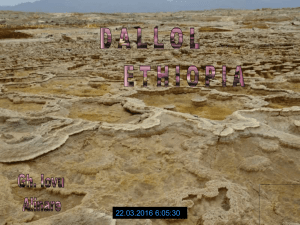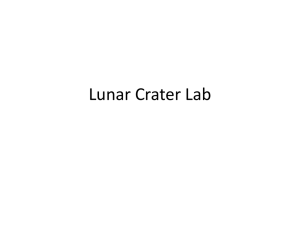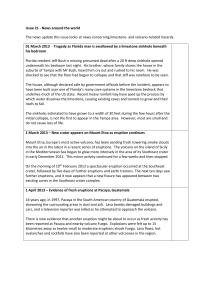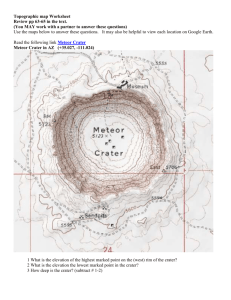Vailulu’u seamount is an active under- series of distinct ecological settings
advertisement
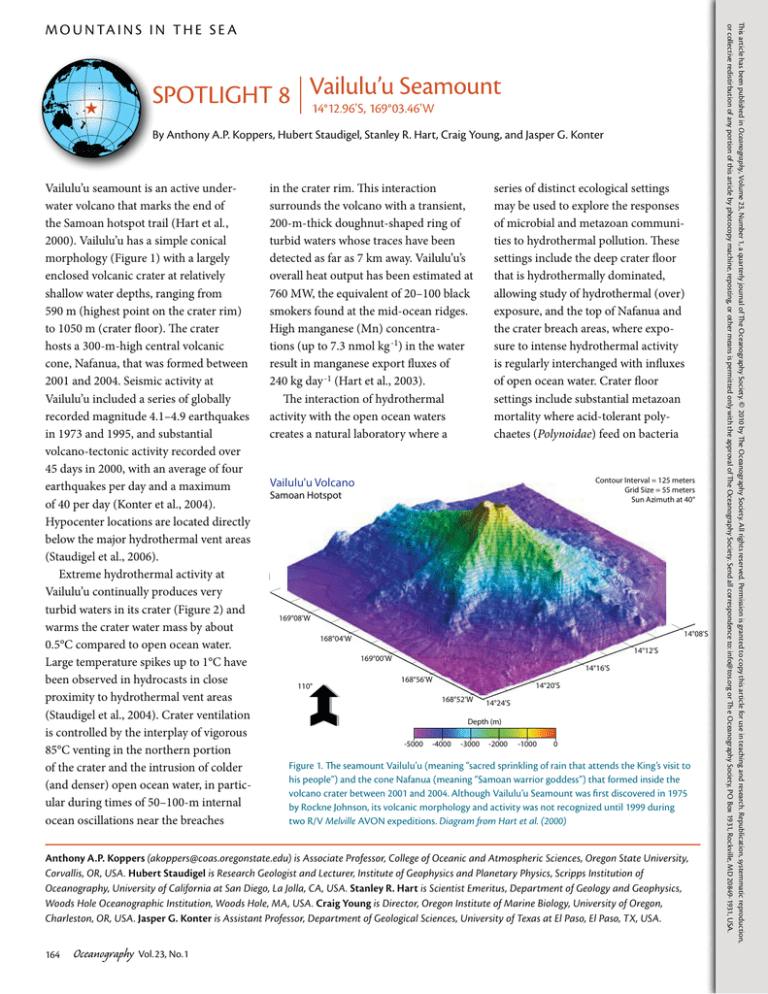
Seamount SPOTLIGHT 8 Vailulu’u 14°12.96'S, 169°03.46'W By Anthony A.P. Koppers, Hubert Staudigel, Stanley R. Hart, Craig Young, and Jasper G. Konter Vailulu’u seamount is an active underwater volcano that marks the end of the Samoan hotspot trail (Hart et al., 2000). Vailulu’u has a simple conical morphology (Figure 1) with a largely enclosed volcanic crater at relatively shallow water depths, ranging from 590 m (highest point on the crater rim) to 1050 m (crater floor). The crater hosts a 300-m-high central volcanic cone, Nafanua, that was formed between 2001 and 2004. Seismic activity at Vailulu’u included a series of globally recorded magnitude 4.1–4.9 earthquakes in 1973 and 1995, and substantial volcano-tectonic activity recorded over 45 days in 2000, with an average of four earthquakes per day and a maximum of 40 per day (Konter et al., 2004). Hypocenter locations are located directly below the major hydrothermal vent areas (Staudigel et al., 2006). Extreme hydrothermal activity at Vailulu’u continually produces very turbid waters in its crater (Figure 2) and warms the crater water mass by about 0.5°C compared to open ocean water. Large temperature spikes up to 1°C have been observed in hydrocasts in close proximity to hydrothermal vent areas (Staudigel et al., 2004). Crater ventilation is controlled by the interplay of vigorous 85°C venting in the northern portion of the crater and the intrusion of colder (and denser) open ocean water, in particular during times of 50–100-m internal ocean oscillations near the breaches in the crater rim. This interaction surrounds the volcano with a transient, 200-m-thick doughnut-shaped ring of turbid waters whose traces have been detected as far as 7 km away. Vailulu’u’s overall heat output has been estimated at 760 MW, the equivalent of 20–100 black smokers found at the mid-ocean ridges. High manganese (Mn) concentrations (up to 7.3 nmol kg -1) in the water result in manganese export fluxes of 240 kg day -1 (Hart et al., 2003). The interaction of hydrothermal activity with the open ocean waters creates a natural laboratory where a series of distinct ecological settings may be used to explore the responses of microbial and metazoan communities to hydrothermal pollution. These settings include the deep crater floor that is hydrothermally dominated, allowing study of hydrothermal (over) exposure, and the top of Nafanua and the crater breach areas, where exposure to intense hydrothermal activity is regularly interchanged with influxes of open ocean water. Crater floor settings include substantial metazoan mortality where acid-tolerant polychaetes (Polynoidae) feed on bacteria Contour Interval = 125 meters Grid Size = 55 meters Sun Azimuth at 40° Vailulu'u Volcano Samoan Hotspot 169°08'W 14°08'SS 168°04'W 14°12'S 169°00'W 14°16'S 110° 168°56'W 14°20'S 168°52'W 14°24'S Depth (m) -5000 -4000 -3000 -2000 -1000 0 Figure 1. The seamount Vailulu’u (meaning “sacred sprinkling of rain that attends the King’s visit to his people”) and the cone Nafanua (meaning “Samoan warrior goddess”) that formed inside the volcano crater between 2001 and 2004. Although Vailulu’u Seamount was first discovered in 1975 by Rockne Johnson, its volcanic morphology and activity was not recognized until 1999 during two R/V Melville AVON expeditions. Diagram from Hart et al. (2000) Anthony A.P. Koppers (akoppers@coas.oregonstate.edu) is Associate Professor, College of Oceanic and Atmospheric Sciences, Oregon State University, Corvallis, OR, USA. Hubert Staudigel is Research Geologist and Lecturer, Institute of Geophysics and Planetary Physics, Scripps Institution of Oceanography, University of California at San Diego, La Jolla, CA, USA. Stanley R. Hart is Scientist Emeritus, Department of Geology and Geophysics, Woods Hole Oceanographic Institution, Woods Hole, MA, USA. Craig Young is Director, Oregon Institute of Marine Biology, University of Oregon, Charleston, OR, USA. Jasper G. Konter is Assistant Professor, Department of Geological Sciences, University of Texas at El Paso, El Paso, TX, USA. 164 Oceanography Vol.23, No.1 This article has been published in Oceanography, Volume 23, Number 1, a quarterly journal of The Oceanography Society. © 2010 by The Oceanography Society. All rights reserved. Permission is granted to copy this article for use in teaching and research. Republication, systemmatic reproduction, or collective redistirbution of any portion of this article by photocopy machine, reposting, or other means is permitted only with the approval of The Oceanography Society. Send all correspondence to: info@tos.org or Th e Oceanography Society, PO Box 1931, Rockville, MD 20849-1931, USA. M O U N TA I N S I N T H E S E A from decaying fish carcasses (Staudigel et al., 2006) and where diverse microbial communities include Fe-, Mn-, H2S-, and CH4-oxidizing Proteobacteria. Near the southeastern crater breach, influx of nutrient-rich open ocean water permits distinct metazoan populations of demosponge (Abyssocladia Brunei) and a colony of cutthroat eels (Dysommina rugosa) to thrive on Nafanua’s summit (Figure 3). Figure 2. Hydrothermal activity in the Vailulu’u crater is intense (Staudigel et al., 2004) with the largest turbidity plumes (registering nephelometer readings up to 1.4 NTU; blue symbols in the left panel) emerging from two venting areas on its crater walls. The closed geometry holds the water within the isolated crater interior (ICI) and a well-mixed basal layer (BL) of the crater, allowing the inside water (orange symbols in the left panel) to warm up to 5.4°C compared to outside 4.4°C open ocean (OO; red symbols in the left panel) water temperatures. Interactions between the ICI-BL and OO water masses result in a variable water mass in the upper and lower breached crater (UBC-LBC) area, where tidal heave causes clear and colder OO water to pour into the crater and mix with the hydrothermally warmed and turbid waters generated inside Vailulu’u’s crater. REFERENCES Hart, S.R., H. Staudigel, A.A.P. Koppers, J. Blusztajn, E.T. Baker, R. Workman, M. Jackson, E. Hauri, M. Kurz, K. Sims, and others. 2000. Vailulu’u undersea volcano: The new Samoa. Geochemistry, Geophysics, Geosystems 1(12), 1056, doi:10.1029/2000GC000108. Hart, S.R., H. Staudigel, R. Workman, A.A.P. Koppers, and A.P. Girard. 2003. A fluorescein tracer release experiment in the hydrothermally active crater of Vailulu’u Volcano, Samoa. Journal of Geophysical Research-Solid Earth 108(B8), 2377, doi:10.1029/2002JB001902. Konter, J.G., H. Staudigel, S.R. Hart, and P.M. Shearer. 2004. Seafloor seismic monitoring of an active submarine volcano: Local seismicity at Vailulu’u Seamount, Samoa. Geochemistry, Geophysics, Geosystems 5, Q06007, doi:10.1029/ 2004GC000702. Staudigel, H., S.R. Hart, A.A.P. Koppers, C. Constable, R. Workman, M. Kurz, and E.T. Baker. 2004. Hydrothermal venting at Vailulu’u Seamount: The smoking end of the Samoan chain. Geochemistry, Geophysics, Geosystems 5, Q02003, doi:10.1029/2003GC000626. Staudigel, H., S.R. Hart, A. Pile, B.E. Bailey, E.T. Baker, S. Brooke, D.P. Connelly, L. Haucke, C.R. German, I. Hudson, and others. 2006. Vailulu’u seamount, Samoa: Life and death on an active submarine volcano. Proceedings of the National Academy of Sciences of the United States of America 103(17):6,448–6,453. A D B E C F Figure 3. After formation of Nafanua volcanic cone, a colony of Dysommina rugosa cutthroat eels took hold on its summit (http://oceanexplorer.noaa.gov/explorations/05vailuluu/welcome.html), although all other macrofauna seem to concentrate on the crater walls and near breach areas (Staudigel et al., 2006). Despite abundant evidence for macro- and microbiological life, toxic hydrothermal fluids pond and form “death” traps in the deepest basins on Vailulu’u’s crater floor. (A) Eel City. (B) Five captured Dysommina rugosa cutthroat eels. (C) Unidentified large isocrinid crinoid from the western rift. (D) Scanning electron microscope image of bacterial mat structures found on basalt surface samples. (E) Fe-mat-covered basalt collected using the Pisces V submersible. (F) A Polynoid Polychaete collected from a fish carcass present on the deepest part of the crater floor. Oceanography March 2010 165

